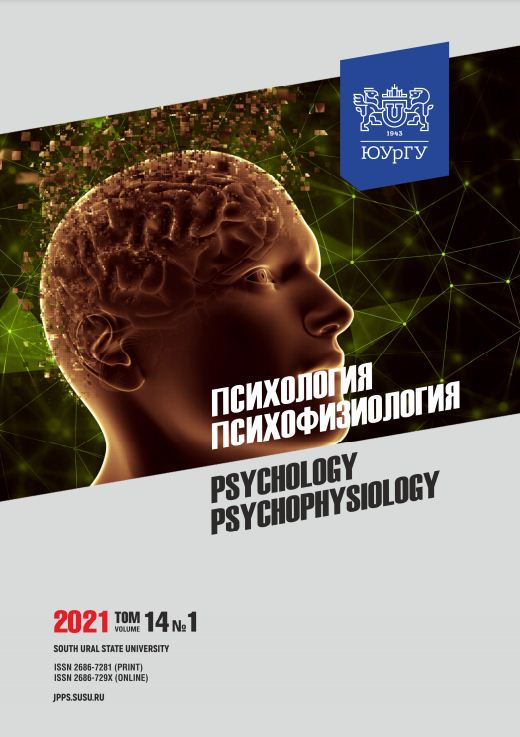NEW APPROACHES TO THE ASSESSMENT OF PSYCHOPHYSIOLOGICAL STATE IN GIFTED ADOLESCENTS
Abstract
Abstract. In gifted children, the features of mental state are revealed expressed in anxiety disorders, hypersensitivity and increased excitability, which require an objective and dynamic assessment of their psychophysiological state. Aim: the paper aims to substantiate the use of the “Bioscope” device for an objective assessment of the psychophysiological state of gifted adolescents and their responses to stress. Materials and methods: Participants were selected out of 500 persons and divided into 2 groups based on the use of psychodiagnostics: 1st group – gifted adolescents of both sexes (n = 35); 2nd group – control (normative) group (n = 35). Psychodiagnostic testing for giftedness was carried out according to the Renzulli three-ring model. To assess the psychophysiological state, the “Bioscope” hardware complex was used, which allows for the remote assessment of the “integral state of the biological system”. The functional state of the subjects was assessed before and after the so-called unsolvable tasks (cognitive load). Results: The study showed that gifted adolescents have a wider range of emotional responses to cognitive load compared to the control group. After performing cognitive tasks, all subjects demonstrated a tendency towards a decrease in oscillation frequency and an increase in the variability of the inter-peak intervals of the “Bioscope” signals. Changes in the spectral power of the “Bioscope” signals were multidirectional: in female participants, the power decreased, while in male participants it increased in both groups of subjects. After cognitive tasks the power values of BB-intervals decreased in gifted adolescents of both sexes and increased in the control group. Conclusion: Psychophysiological responses to cognitive load (unsolvable cognitive tasks) are more pronounced in gifted adolescents compared to the control group; female participants of both groups respond with more pronounced anxiety. The results obtained indicate the prospects of using the “Bioscope” complex in various psychophysiological studies.
Downloads
References
2. Shebanova E.I. Unsuccessful gifted students. Moscow. Publ. BINOM. Laboratory of knowledge. 2013: 247. (in Russ.). https://www.elibrary.ru/item.asp?id=22322282
3. Bogoyavlenskaya D.B., Bogoyavlenskaya M.E. Giftedness: nature and diagnostics. Moscow. Publ. Institute for the Study of Childhood, Family and Upbringing of the Russian Academy of Education. 2018: 239. (in Russ.). https://www.elibrary.ru/item.asp?id=35112256
4. Alias A., Rahman S., Majid R.A., Yassin S. F.M. Dabrowskis overexcitabilities profile among gifted students. Asian Social Science. 2013; 9 (16). DOI:10.5539/ass.v9n16p120
5. Karpinski R.I., Kinase Kolb A.M., Tetreault N.A., Borowski T.B. High intelligence: A risk factor for psychological and physiological overexcitabilities. Intelligence. 2018; 66: 8–23. DOI: 10.1016/j.intell.2017.09.001.
6. Cross T.L. On the Social and Emotional Lives of Gifted Children; Understanding and guiding their development. Fourth Edition. Prufrock Press Inc. Waco, Texas. 2011: 287.
7. Silverman L.K. The Psych 101 Series “Giftedness 101”. Springer Publishing Company. USA. 2013: 292.
8. Paronikyan R.G., Sarkisyan R.Sh., Avagyan M.N. et al. Non-invasive assessment of anti-seizure drugs and their ability to prevent epileptiform changes. Epilepsiya i paroksizmalnye sostoyaniya = Epilepsy and paroxysmal conditions. 2017; 9 (4): 86–95. (in Russ.). DOI: 10.17749/2077-8333.2017.9.4.086-095
9. Kraig G., Bokum D. Psychology of development. St. Petersburg. Piter, 2005: 940. (in Russ.).
10. Sternberg R.J., Jarvin L., Grigorenko E.L. Explorations in giftedness. 2011. Cambridge University Press. DOI: 10.1017/CBO9780511778049
11. Lukyanova M.I., Kalinina N.V. Psychological and pedagogical indicators of school activity: criteria and diagnostics. Moscow. Creative Center Sphere, 2004: 208. (in Russ.). URL: https://www.elibrary.ru/item.asp?id=19911648
12. Sargsyan R.Sh., Karamyan G.G., Avagyan M.N. Noninvasive assessment of physiologic state of living systems. The Journal of Alternative and Complementary Medicin. 2010; 16 (11): 1137–1144. DOI: 10.1089/acm.2010.0108
13. Sargsyan R.Sh., Karamyan G.G. Nonlocal correlations in macroscopic systems: living objects, mental influence and physical processes. NeuroQuantology. 2014; 12 (4): 355–365. DOI: 10.14704/nq.2014.12.4.770
References on translit
.Copyright (c) 2021 Psychology. Psychophysiology

This work is licensed under a Creative Commons Attribution-NonCommercial-NoDerivatives 4.0 International License.



